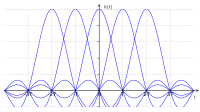
Photo from wikipedia
Noise is usually undesired yet inevitable in science and engineering. However, by introducing the engineered noise to the precise solution of Jones matrix elements, we break the fundamental limit of… Click to show full abstract
Noise is usually undesired yet inevitable in science and engineering. However, by introducing the engineered noise to the precise solution of Jones matrix elements, we break the fundamental limit of polarization multiplexing capacity of metasurfaces that roots from the dimension constraints of the Jones matrix. We experimentally demonstrate up to 11 independent holographic images using a single metasurface illuminated by visible light with different polarizations. To the best of our knowledge, it is the highest capacity reported for polarization multiplexing. Combining the position multiplexing scheme, the metasurface can generate 36 distinct images, forming a holographic keyboard pattern. This discovery implies a new paradigm for high-capacity optical display, information encryption, and data storage. Description For more information, make some noise Holograms can be considered large-capacity memory storage media that are capable of holding information about three-dimensional scenes and compressing it into a two-dimensional pattern (metasurface). Attempting to store more images onto the one hologram pattern tends to result in cross talk and corruption of the stored data. Xiong et al. found that introducing engineered noise into the process enabled an increase in storage capacity. This approach should work for metasurfaces in applications such as high-capacity optical displays, information encryption, and data storage. —ISO Engineered noise can increase the channel capacity for polarization multiplexing with a metasurface hologram.
Journal Title: Science
Year Published: 2023
Link to full text (if available)
Share on Social Media: Sign Up to like & get
recommendations!